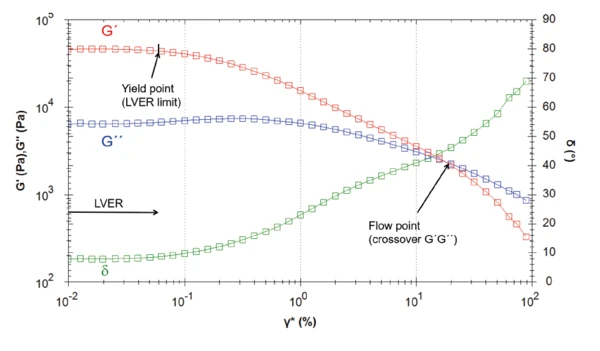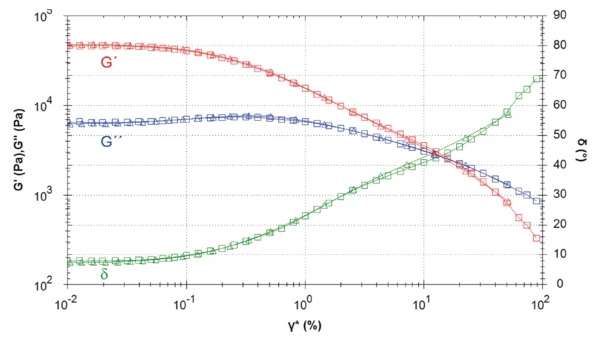Introduction
The rheological properties of materials help understand and anticipate their behavior during their processing. For example, they play a role in the lubrication ability, pumpability, and flow (yield/drop) point of lubricating greases.
The shear viscosity measurement of a lubricating grease according to DIN 51810-1 standard is described in our AN 222 [1]. In the following, the yield and the flow points of this material are determined with the Kinexus pro+ using the measurement conditions stipulated in DIN51810-2.
Measurement Conditions
Table 1 summarizes the test parameters specified in this standard [2]. Two different methods are described: The amplitude sweep can be StrainStrain describes a deformation of a material, which is loaded mechanically by an external force or stress. Rubber compounds show creep properties, if a static load is applied.strain or StressStress is defined as a level of force applied on a sample with a well-defined cross section. (Stress = force/area). Samples having a circular or rectangular cross section can be compressed or stretched. Elastic materials like rubber can be stretched up to 5 to 10 times their original length.stress controlled, corresponding to methods A and B, respectively. In this work, both methods are employed.
Table 1: Measurement conditions
| Measurement type | Oscillation | |
| Geometry | PP25 (Parallel plate system, diameter: 25 mm) | |
| Temperature | 25°C (±0.1°C) | |
| Trimming gap | 1.025 mm | |
| Measurement gap | 1 mm | |
| Frequency | 1.59 Hz (corresponds to an angular frequency ω = 10 rad/s) | |
| Method A: Amplitude StrainStrain describes a deformation of a material, which is loaded mechanically by an external force or stress. Rubber compounds show creep properties, if a static load is applied.strain sweep | 0.01 to 100% | |
| Method B: Amplitude StressStress is defined as a level of force applied on a sample with a well-defined cross section. (Stress = force/area). Samples having a circular or rectangular cross section can be compressed or stretched. Elastic materials like rubber can be stretched up to 5 to 10 times their original length.stress sweep | 0 to 1,000 Pa | |
Measurement Results
Figure 1 depicts the elastic and viscous shear modulus G´ and G” curves along with the phase angle curve during the amplitude StrainStrain describes a deformation of a material, which is loaded mechanically by an external force or stress. Rubber compounds show creep properties, if a static load is applied.strain sweep. At low deformations, the grease is in the linear viscoelastic range (Linear Viscoelastic Region (LVER)In the LVER, applied stresses are insufficient to cause structural breakdown (yielding) of the structure and hence important micro-structural properties are being measured.LVER), as taken from the plateau of the shear modulus curves. Here, the values for G´ and G” are constant, as the shear StressStress is defined as a level of force applied on a sample with a well-defined cross section. (Stress = force/area). Samples having a circular or rectangular cross section can be compressed or stretched. Elastic materials like rubber can be stretched up to 5 to 10 times their original length.stress and shear StrainStrain describes a deformation of a material, which is loaded mechanically by an external force or stress. Rubber compounds show creep properties, if a static load is applied.strain are proportional; the applied strains do not lead to a breakdown of the sample´s structure. In this range, the elastic component is higher than the viscous, so that the solid-like properties dominate over the liquidlike properties of the grease for the selected measurement conditions. This behavior can also be taken from the phase angle curve being lower than 45° (see description of the phase angle in the green box).
From a deformation of 0.1%, the Elastic modulusThe complex modulus (elastic component), storage modulus, or G’, is the “real” part of the samples the overall complex modulus. This elastic component indicates the solid like, or in phase, response of the sample being measurement. elastic modulus curve (red) begins to decrease. This effect is related to the start of the breakdown of the sample’s associated (internal) structure and indicates the end of the Linear Viscoelastic Region (LVER)In the LVER, applied stresses are insufficient to cause structural breakdown (yielding) of the structure and hence important micro-structural properties are being measured.LVER (Linear Viscoelastic Region). The limit of this range is defined as yield point or also linearity limit at which the shear StrainStrain describes a deformation of a material, which is loaded mechanically by an external force or stress. Rubber compounds show creep properties, if a static load is applied.strain (γY) and the shear StressStress is defined as a level of force applied on a sample with a well-defined cross section. (Stress = force/area). Samples having a circular or rectangular cross section can be compressed or stretched. Elastic materials like rubber can be stretched up to 5 to 10 times their original length.stress (σY) can be determined (see table 2).
A further increase in StrainStrain describes a deformation of a material, which is loaded mechanically by an external force or stress. Rubber compounds show creep properties, if a static load is applied.strain leads to a crossover of G´ and G”. This point can be defined as the flow point of the grease. The related shear StrainStrain describes a deformation of a material, which is loaded mechanically by an external force or stress. Rubber compounds show creep properties, if a static load is applied.strain and shear StressStress is defined as a level of force applied on a sample with a well-defined cross section. (Stress = force/area). Samples having a circular or rectangular cross section can be compressed or stretched. Elastic materials like rubber can be stretched up to 5 to 10 times their original length.stress are called γF and σF, respectively. If strains higher than the flow point are applied to the material, then it will begin to flow for the selected measurement conditions, i.e., for the used frequency.
The yield-flow index is defined as σF/σγ. This value gives information about the brittleness of the grease. In this case, it is much higher than 1, showing that the grease features an enduring behavior. Table 2 summarizes all values determined with the measurement on grease.
Phase Angle
The phase angle is a realitve measure of the viscous and elastic properties of a material. It ranges from 0° for a fully elastic material to 90° for a fully viscous material.

Table 2: Evaluation of the measurement
As displayed in figure 2, the rSpace software is capable of providing automatic evaluation of the required values as soon as the measurement is finished.
Figure 3 displays the curves resulting from the amplitude StressStress is defined as a level of force applied on a sample with a well-defined cross section. (Stress = force/area). Samples having a circular or rectangular cross section can be compressed or stretched. Elastic materials like rubber can be stretched up to 5 to 10 times their original length.stress sweep measurement (method B described in DIN 51810-2).
The strain inducing by the applied shear StressStress is defined as a level of force applied on a sample with a well-defined cross section. (Stress = force/area). Samples having a circular or rectangular cross section can be compressed or stretched. Elastic materials like rubber can be stretched up to 5 to 10 times their original length.stress can also be displayed in the x-axis for better comparison of the curves (figure 4). It shows the good repeatability of the measurements.



Conclusion
Tests according to the second part of DIN51810 were performed on a lubricating grease. The subsequent evaluation for the determination of the yield and flow point was automatically carried out by the rSpace software.